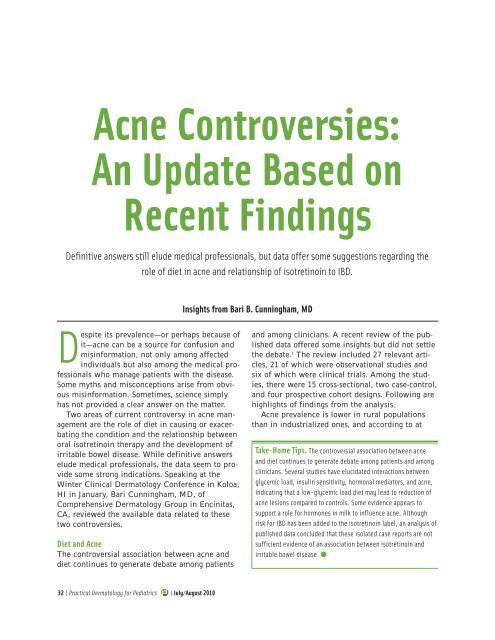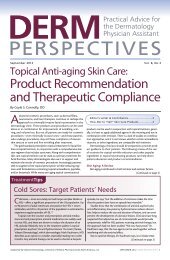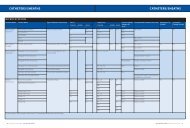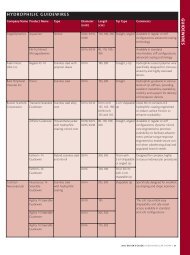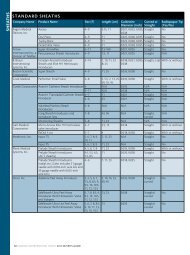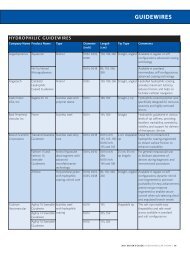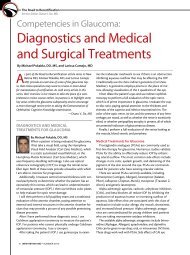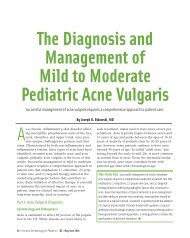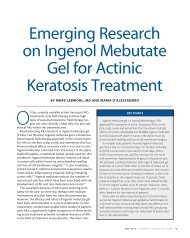Acne Controversies: An Update Based on Recent Findings
Acne Controversies: An Update Based on Recent Findings
Acne Controversies: An Update Based on Recent Findings
You also want an ePaper? Increase the reach of your titles
YUMPU automatically turns print PDFs into web optimized ePapers that Google loves.
<str<strong>on</strong>g>Acne</str<strong>on</strong>g> <str<strong>on</strong>g>C<strong>on</strong>troversies</str<strong>on</strong>g>:<br />
<str<strong>on</strong>g>An</str<strong>on</strong>g> <str<strong>on</strong>g>Update</str<strong>on</strong>g> <str<strong>on</strong>g>Based</str<strong>on</strong>g> <strong>on</strong><br />
<strong>Recent</strong> <strong>Findings</strong><br />
Definitive answers still elude medical professi<strong>on</strong>als, but data offer some suggesti<strong>on</strong>s regarding the<br />
role of diet in acne and relati<strong>on</strong>ship of isotretinoin to IBD.<br />
Insights from Bari B. Cunningham, MD<br />
Despite its prevalence—or perhaps because of<br />
it—acne can be a source for c<strong>on</strong>fusi<strong>on</strong> and<br />
misinformati<strong>on</strong>, not <strong>on</strong>ly am<strong>on</strong>g affected<br />
individuals but also am<strong>on</strong>g the medical professi<strong>on</strong>als<br />
who manage patients with the disease.<br />
Some myths and misc<strong>on</strong>cepti<strong>on</strong>s arise from obvious<br />
misinformati<strong>on</strong>. Sometimes, science simply<br />
has not provided a clear answer <strong>on</strong> the matter.<br />
Two areas of current c<strong>on</strong>troversy in acne management<br />
are the role of diet in causing or exacerbating<br />
the c<strong>on</strong>diti<strong>on</strong> and the relati<strong>on</strong>ship between<br />
oral isotretinoin therapy and the development of<br />
irritable bowel disease. While definitive answers<br />
elude medical professi<strong>on</strong>als, the data seem to provide<br />
some str<strong>on</strong>g indicati<strong>on</strong>s. Speaking at the<br />
Winter Clinical Dermatology C<strong>on</strong>ference in Koloa,<br />
HI in January, Bari Cunningham, MD, of<br />
Comprehensive Dermatology Group in Encinitas,<br />
CA, reviewed the available data related to these<br />
two c<strong>on</strong>troversies.<br />
Diet and <str<strong>on</strong>g>Acne</str<strong>on</strong>g><br />
The c<strong>on</strong>troversial associati<strong>on</strong> between acne and<br />
diet c<strong>on</strong>tinues to generate debate am<strong>on</strong>g patients<br />
and am<strong>on</strong>g clinicians. A recent review of the published<br />
data offered some insights but did not settle<br />
the debate. 1 The review included 27 relevant articles,<br />
21 of which were observati<strong>on</strong>al studies and<br />
six of which were clinical trials. Am<strong>on</strong>g the studies,<br />
there were 15 cross-secti<strong>on</strong>al, two case-c<strong>on</strong>trol,<br />
and four prospective cohort designs. Following are<br />
highlights of findings from the analysis.<br />
<str<strong>on</strong>g>Acne</str<strong>on</strong>g> prevalence is lower in rural populati<strong>on</strong>s<br />
than in industrialized <strong>on</strong>es, and according to at<br />
Take-Home Tips. The c<strong>on</strong>troversial associati<strong>on</strong> between acne<br />
and diet c<strong>on</strong>tinues to generate debate am<strong>on</strong>g patients and am<strong>on</strong>g<br />
clinicians. Several studies have elucidated interacti<strong>on</strong>s between<br />
glycemic load, insulin sensitivity, horm<strong>on</strong>al mediators, and acne,<br />
indicating that a low-glycemic load diet may lead to reducti<strong>on</strong> of<br />
acne lesi<strong>on</strong>s compared to c<strong>on</strong>trols. Some evidence appears to<br />
support a role for horm<strong>on</strong>es in milk to influence acne. Although<br />
risk for IBD has been added to the isotretinoin label, an analysis of<br />
published data c<strong>on</strong>cluded that these isolated case reports are not<br />
sufficient evidence of an associati<strong>on</strong> between isotretinoin and<br />
irritable bowel disease. ●<br />
32 | Practical Dermatology for Pediatrics | July/August 2010
<str<strong>on</strong>g>Acne</str<strong>on</strong>g> <str<strong>on</strong>g>C<strong>on</strong>troversies</str<strong>on</strong>g><br />
least two studies, acne prevalence increases as<br />
populati<strong>on</strong>s adopt a Western diet, whether through<br />
migrati<strong>on</strong> or cultural change. A western diet c<strong>on</strong>sists<br />
of high proporti<strong>on</strong>s of food with a high<br />
glycemic index (see below), as well as more<br />
processed foods, soda, beef, and dairy, according<br />
to these reviews, while n<strong>on</strong>-Western diets emphasize<br />
fruits, vegetables (including root vegetables)<br />
and <strong>on</strong>ly a small proporti<strong>on</strong> of flour, sugar, and<br />
meat.<br />
The issue of milk c<strong>on</strong>sumpti<strong>on</strong> and acne has<br />
been an area of debate. The current analysis highlighted<br />
three large studies that reported a positive<br />
associati<strong>on</strong> between milk intake and acne. Milk<br />
c<strong>on</strong>sumpti<strong>on</strong> was associated with increased risk<br />
for acne as well as increased acne severity. The fat<br />
c<strong>on</strong>tent of milk (skim versus whole) has not been<br />
found to influence its associati<strong>on</strong> with acne, suggesting<br />
that horm<strong>on</strong>es in milk may therefore play<br />
a role in mediating the skin disease. Horm<strong>on</strong>es in<br />
milk—IGF-1, 5α-reduced steroids, and α-lactalbumin—can<br />
survive processing and may affect the<br />
pilosebaceous unit. Milk c<strong>on</strong>sumpti<strong>on</strong> increases<br />
IGF-1 producti<strong>on</strong>, which has been associated with<br />
increased ovarian androgen producti<strong>on</strong>.<br />
Several studies have elucidated interacti<strong>on</strong>s<br />
between glycemic load, insulin sensitivity, horm<strong>on</strong>al<br />
mediators, and acne, indicating that a lowglycemic<br />
load diet may lead to reducti<strong>on</strong> of acne<br />
lesi<strong>on</strong>s compared to c<strong>on</strong>trols. C<strong>on</strong>sumpti<strong>on</strong> of high<br />
glycemic index foods elevates serum insulin c<strong>on</strong>centrati<strong>on</strong>s;<br />
elevated serum insulin levels are<br />
thought to stimulate sebocyte proliferati<strong>on</strong> and<br />
sebum producti<strong>on</strong>, suppress sex horm<strong>on</strong>e binding<br />
globulin (SHBG) c<strong>on</strong>centrati<strong>on</strong>s, and raise androgen<br />
levels. C<strong>on</strong>sumpti<strong>on</strong> of low-glycemic-index<br />
foods is associated with increased SHBG levels—<br />
linked with lower acne severity—and decreased<br />
androgen levels.<br />
Chocolate was not associated with exacerbati<strong>on</strong><br />
of acne in two studies that were reviewed in the<br />
recent analysis.<br />
Isotretinoin <str<strong>on</strong>g>Update</str<strong>on</strong>g>s<br />
The package insert for isotretinoin now has a<br />
warning for inflammatory bowel disease (IBD):<br />
Inflammatory Bowel Disease: [isotretinoin] has<br />
been associated with inflammatory bowel disease<br />
(including regi<strong>on</strong>al ileitis) in patients<br />
without a prior history of intestinal disorders.<br />
In some instances, symptoms have been<br />
reported to persist after [isotretinoin] treatment<br />
has been stopped. Patients experiencing<br />
abdominal pain, rectal bleeding or severe<br />
diarrhea should disc<strong>on</strong>tinue Accutane immediately.<br />
IBD is also listed as a possible adverse reacti<strong>on</strong> to<br />
isotretinoin. FDA ordered IBD risk be added to the<br />
label in 2005. N<strong>on</strong>etheless, the associati<strong>on</strong><br />
between IBD and isotretinoin has been c<strong>on</strong>troversial.<br />
<strong>Recent</strong>ly, a New Jersey court awarded $12.9 milli<strong>on</strong><br />
to three patients who developed IBD after<br />
being treated with istoretinoin. The settlement in<br />
this case generated significant media attenti<strong>on</strong>,<br />
although other suits preceded it, and numerous<br />
law offices c<strong>on</strong>tinue to actively recruit potentially<br />
affected patients.<br />
A 2009 analysis sought to assess the risk of IBD<br />
associated with isotretinoin. 2 The analysis uncovered<br />
12 relevant case reports and <strong>on</strong>e case series<br />
from seven countries published in the preceding<br />
23 years. No prospective studies had been published.<br />
The identified publicati<strong>on</strong>s all reported an<br />
associati<strong>on</strong> between isotretinoin use and subsequent<br />
development of IBD, however, they differed<br />
with respect to reported isotretinoin dose, durati<strong>on</strong><br />
of treatment, the <strong>on</strong>set of disease in relati<strong>on</strong> to<br />
therapy (whether <strong>on</strong> or off medicati<strong>on</strong>), and the<br />
clinical presentati<strong>on</strong> of IBD. The authors c<strong>on</strong>cluded<br />
that these isolated case reports are not sufficient<br />
evidence of an associati<strong>on</strong> between<br />
isotretinoin and IBD. Assuming no increased risk<br />
for IBD, estimates predict 59 coincident cases of<br />
IBD each year in the populati<strong>on</strong> of patients using<br />
isotretinoin.<br />
The authors speculate that the natural course of<br />
IBD could c<strong>on</strong>tribute to an apparent temporal<br />
associati<strong>on</strong> between IBD and isotretinoin. IBD is<br />
most comm<strong>on</strong>ly diagnosed in individuals under<br />
July/August 2010 | Practical Dermatology for Pediatrics | 33
<str<strong>on</strong>g>Acne</str<strong>on</strong>g> <str<strong>on</strong>g>C<strong>on</strong>troversies</str<strong>on</strong>g><br />
age 35, and frequent bouts of abdominal pain and<br />
diarrhea in childhood are often reported by<br />
patients. A genetic basis of IBD is suspected. IBD<br />
is a chr<strong>on</strong>ic disorder, and symptoms are known to<br />
wax and wane. 3<br />
Given these features of IBD, it seems possible<br />
that patients with subclinical disease could be prescribed<br />
isotretinoin. As IBD flares, isotretini<strong>on</strong><br />
may be assumed by the patient and/or physician to<br />
have incited the incident and may be withdrawn.<br />
By the time treatment is withdrawn, IBD may naturally<br />
be entering a n<strong>on</strong>-symptomatic phase, further<br />
implicating isotretinoin in the development of<br />
GI symptoms. As such, chance, c<strong>on</strong>founding bias,<br />
and misrepresentati<strong>on</strong> of the natural course of IBD<br />
could c<strong>on</strong>tribute to an apparent associati<strong>on</strong><br />
between isotretinoin and IBD. 2<br />
More recently, the same group reported results<br />
of a case-c<strong>on</strong>trol study of isotretinoin and IBD<br />
using a large insurance claims database.<br />
Researchers identified incident cases of IBD and<br />
Insights into <str<strong>on</strong>g>Acne</str<strong>on</strong>g> Therapy Adherence<br />
Medicati<strong>on</strong>s requiring less frequent dosing appear to promote<br />
therapeutic adherence am<strong>on</strong>g acne patients. <str<strong>on</strong>g>An</str<strong>on</strong>g> analysis of current<br />
literature <strong>on</strong> medicati<strong>on</strong> adherence in teenagers with acne<br />
found a positive correlati<strong>on</strong> between quality of life of patients<br />
with acne and medicati<strong>on</strong> adherence (Journal of Cosmetic<br />
Dermatology 9(2):160-166).<br />
Predictors of adherence (though weak) include increased age,<br />
female gender, and employment. The most comm<strong>on</strong>ly reported<br />
reas<strong>on</strong> for n<strong>on</strong>-adherence was inadequate time to use the prescribed<br />
medicati<strong>on</strong>.<br />
The analysis found better adherence associated with less frequent<br />
dosing and determined that medicati<strong>on</strong> adherence correlated<br />
with better health status am<strong>on</strong>g acne patients. L<strong>on</strong>ger<br />
durati<strong>on</strong>s between office visits may decrease compliance, the<br />
authors say.<br />
—PD Editorial Staff<br />
matched to three c<strong>on</strong>trols <strong>on</strong> the basis of age, gender,<br />
geographical regi<strong>on</strong>, health plan, and length of<br />
enrollment. C<strong>on</strong>diti<strong>on</strong>al logistic regressi<strong>on</strong> was<br />
used to adjust for matching variables. In total,<br />
8,189 cases of IBD were identified (3,664 Crohn's<br />
disease (CD), 4,428 ulcerative colitis (UC), and 97<br />
IBD unspecified) and matched to 21,832 c<strong>on</strong>trols.<br />
A total of 60 subjects (24 cases and 36 c<strong>on</strong>trols)<br />
were exposed to isotretinoin.<br />
While UC was str<strong>on</strong>gly associated with previous<br />
isotretinoin exposure (odds ratio (OR) 4.36, 95%<br />
c<strong>on</strong>fidence interval (CI): 1.97, 9.66), there was no<br />
apparent associati<strong>on</strong> between isotretinoin and CD<br />
(OR 0.68, 95% CI: 0.28, 1.68). Increasing dose of<br />
isotretinoin was associated with elevated risk of<br />
UC (OR per 20 mg increase in dose: 1.50, 95% CI:<br />
1.08, 2.09). Overall, the study c<strong>on</strong>cluded the<br />
absolute risk of developing UC after taking<br />
isotretinoin “is likely quite small.” 4<br />
<str<strong>on</strong>g>An</str<strong>on</strong>g>other area of study involving isotretinoin is<br />
its use in toddler acne, which has been reported to<br />
be safe and effective. 5,6 Although the etiology of<br />
infantile acne is not fully understood, androgen<br />
influence <strong>on</strong> sebaceous glands is thought to be the<br />
primary driver of the presentati<strong>on</strong>. 5 Typical dosage<br />
of isotretinoin for infants and toddlers is<br />
0.2mg/kg/day to 1.5mg/kg/day. Isotretinoin tablets<br />
can be split, and half a tablet can be pressed into a<br />
slice of a soft-centered candy bar (such as a Milky<br />
Way) so that a child can easily c<strong>on</strong>sume it. ■<br />
1. Spencer EH, Ferdowsian HR, Barnard ND. Diet and acne: a review of the<br />
evidence. Int J Dermatol. 2009 Apr;48(4):339-47.<br />
2. Crockett SD, Gulati A, Sandler RS, Kappelman MD. A causal associati<strong>on</strong><br />
between isotretinoin and inflammatory bowel disease has yet to be<br />
established. Am J Gastroenterol. 2009 Oct;104(10):2387-93.<br />
3. Noddin L, Callahan M, Lacy BE. Irritable bowel syndrome and functi<strong>on</strong>al<br />
dyspepsia: different diseases or a single disorder with different manifestati<strong>on</strong>s?<br />
MedGenMed. 2005 Aug 29;7(3):17.<br />
4. Crockett SD, Porter CQ, Martin CF, Sandler RS, Kappelman MD.<br />
Isotretinoin Use and the Risk of Inflammatory Bowel Disease: A Case-<br />
C<strong>on</strong>trol Study. Am J Gastroenterol.<br />
5. Mengesha YM, Hansen RC. Toddler-age nodulocystic acne. J Pediatr.<br />
1999 May;134(5):644-8.<br />
6. Léauté-Labrèze C, Gautier C, Labbé L, Taieb A. [Infantile acne and<br />
isotretinoin]. <str<strong>on</strong>g>An</str<strong>on</strong>g>n Dermatol Venereol. 1998 Feb;125(2):132-4.<br />
34 | Practical Dermatology for Pediatrics | July/August 2010


